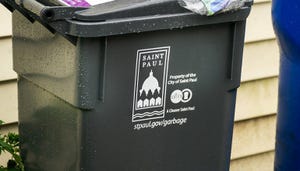New Technologies in the Works for Onboard CNG Storage
Refuse fleets have faced challenges when it comes to storing high-pressure fuel on their trucks. Here’s a look at three technologies that could help improve efficiency.
More refuse companies are investing in compressed natural gas (CNG) sourced from cleaned biomethane (renewable natural gas), storing it on board in cylinders. For some time, storing this high-pressure fuel on trucks came with challenges for fleets, and though the industry has since taken down significant hurdles, there are new innovations in the pipeline for greater efficiency. Three technologies in particular are receiving a lot of attention.
“Because CNG is compressed to 3,600 pounds per square inch (PSI), it has to be stored in a cylindrical container so the tank does not rupture. This requires large onboard cylinders that take up real estate and somewhat limit onboard fuel capacity,” says Dan Bowerson, director of technology and development at NGVAmerica, a trade organization advancing use of natural gas vehicles. “The refuse industry has figured out how to accommodate more onboard fuel, and vehicles have been designed to allow practical placement of cylinders, but research and development is aimed at further improvement.”
For now, tanks are typically stored either on the roof of the body, behind the cab or on the rails, though the newest way is inside the lift gate at the rear of the body. The latter option offers the most storage—up to 105 diesel gallon equivalents (DGEs), while the typical truck carries 60 to 75 DGEs on board, says Christopher Logan, director of national accounts for Clean Energy.
Current research and development is focused mainly on technologies to include casting, continuous carbon fiber wrapped and adsorbed natural gas. The casting solution is to reform containers’ shape to address pressure issues while allowing the tank to fit more conformably.
Continuous carbon fiber features carbon wrapping around the storage system via a long extrusion. This configuration allows sections of the gas storage system to be snaked around different vehicle components to fit more comfortably while maintaining pressure.
With adsorption, gas molecules soak into the surface of a porous material in the vessel, coming closer together and ultimately lowering pressure, which is intended to come with benefits, says Ted Barnes, research and development manager for the Gas Technology Institute (GTI), which is researching this technology and others.
“Theoretically, if you can store at low pressure, you could store more in smaller areas by packing the gas molecules closer together. But there are technical hurdles that need to be overcome before this could be commercialized,” he says.
American Natural Gas, which builds CNG stations, and others are working on adsorbed natural gas technology.
Meanwhile, businesses like Westport, a natural gas company, are focusing on conformable, high-pressure storage systems using smaller diameter tubing that can be shaped to better fit heavy-duty vehicles.
“You could use this storage system to get more gas in an irregular shape to free up space on the vehicle,” says Barnes.
“I think there is a lot of promise with these technologies, but [developers] need to get over regulatory hurdles, which are less for high-pressure systems because the refuse industry has addressed issues around pressure storage,” adds Barnes.
Noble Gas in Farmington, Mich., developed a storage system with a thermal plastic liner to hold the gas and prevent permeation. A synthetic, woven fiber ensures burst requirements (amount of pressure that can be safely held). And there’s a protective shell for the cylinder.
“We don’t use a lot of resin, which allows for parts to be light,” says Steve Johnston, an engineer at Noble Gas. “We think our technique will work at high pressures and be able to give weight reduction, which will translate to fuel cost reductions over current systems.”
While Johnston could not say how many more miles a gallon a truck would get, he explains the tanks can be 30 to 70 percent lighter than large cylinder tanks in use today. Noble anticipates having a finished product by the third quarter of 2018, and then the plan would be to commercialize it.
“Fuel storage on board gas vehicles is well proven and established. But with all industries and technologies, there is continuous improvement going on. And in coming years, there will be changes and improvements to natural gas fuel and dispensing systems,” projects Barnes.
About the Author(s)
You May Also Like




